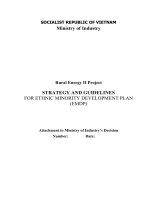AP Development Plan Version 2013-2014
Bạn đang xem bản rút gọn của tài liệu. Xem và tải ngay bản đầy đủ của tài liệu tại đây (94.84 KB, 5 trang )
LEADERSHIP DEVELOPMENT PROGRAM
Mission Statement:
To provide quality instruction in a safe caring
environment.
Vision:
Every student will graduate from high school, be
globally competitive for work or postsecondary
education, and be prepared for life in the 21st century.
A NEW VISION OF SCHOOL LEADERSHIP
Public education has changed its mission and now dictates the need for a new style in school
leadership – executive rather than administrator. No longer are school leaders maintaining the
status quo by managing complex operations, but just like their colleagues in business, they must
also be able to create schools as organizations that can learn and change quickly if they are to
improve performance. Schools need executives who are adept at creating systems for change –
executives who can build relationships with and across staff that not only tap into the collective
knowledge and insight they possess, but also tap into powerful relationships that stir their
passions for their work with children. From these relationships, the executive must create a
common, shared understanding of the school’s purpose, its values that direct its action, and its
commitment and ownership of beliefs and goals that drive everyone’s decision making. The staff
members’ common understanding of the school’s identity empowers them to seek and build
powerful alliances and partnerships with students, parents and community stakeholders in order
to enhance their ability to produce increased student achievement. The successful work of the
new executive will only be realized in the creation of a culture where leadership is distributed
and encouraged among teachers. It must consist of open, honest communication that is focused
on the use of data, and where teamwork, research-based best practices, and modern tools are
used to drive ethical, principled, and goal-oriented action. This culture of disciplined thought and
action is rooted in the ability of the relationships among all stakeholders to build a trusting,
transparent environment that reduces all stakeholders’ sense of vulnerability as they address the
challenges of transformational change.
PHILOSOPHICAL STANDARDS FOR THE NEW SCHOOL ADMINISTRATOR
The standards are predicated on the following beliefs:
Today, schools must have proactive school executives who possess a great sense of urgency.
The goal of school leadership is to transform schools so that large-scale, sustainable,
continuous improvement becomes built in to their mode of operation.
The moral purpose of school leadership is to create schools in which all students learn, the
gap between high and low performance is greatly diminished, and what students learn will
prepare them for success in their futures, not ours.
Leadership is not a position or a person. It is a practice that must be embedded in all job
roles at all levels of the school district.
The work of leadership is about working with, for and through people. It is a social act.
Whether we are discussing instructional leadership, change in leadership or leadership as
learning, people are always the medium for the leader.
Leadership is not about doing everything oneself, but it is always about creating processes
and systems that will cause everything to happen.
Leadership is about the executive’s ability to select and develop a strong executive staff
whose complementary strengths promote excellence in all seven functions of leadership
identified in this document.
The concept of leadership is extremely complex and systemic in nature. Isolating the parts of
leadership completely misses the power of the whole. It is not just knowing what to do, but
why to do it, how to do it and when to do it.
Within a school district there are nested leadership systems (local boards of education,
central office, school, and classroom). For the organization to be successful these systems
must be aligned and supportive, and function as a team.
Leadership is about setting direction, aligning and motivating people to implement positive
sustained improvement.
Leaders bring their “person” to the practice of leadership. Matching the context of
leadership to the “person” of the individual is important to the success of the leader.
THE SEVEN STANDARDS OF EXECUTIVE LEADERSHIP
Strategic Leadership
Instructional Leadership
Cultural Leadership
Human Resource Leadership
Managerial Leadership
External Development Leadership
Micro-political Leadership
PROGRAM OUTLINE
Objective: Caldwell County Schools require administrators who are capable, willing and ready
to lead students, schools and communities into the Twenty-First Century.
Day
Monday
9/30
Time
8:30
AM –
3 PM
Thursday
10/10
3-6
PM
Tuesday
10/22
Thursday
11/14
Wednesday
11/20
Wednesday
12/11
Monday
1/13
Tuesday
1/28
3-6
PM
3-6
PM
3-6
PM
3-5
PM
2-6
PM
3-5
PM
Topic
Presenter
Hours
Relationships and Caldwell
County
Libby Brown and Chamber
of Commerce
6.5
Stone, Burns, and EPS Staff
3
Stone, Burns, EPS Staff, and
Miller
3
Stone and Board Members
3
Stone
3
Stone and Johnson
2
Curriculum Initiatives by Grade
Levels/Title 1, and Exceptional
Children
Assessments, Data, Plans,
Reports, and Finance
Conversations and Q/A with
Board Members
Superintendent and Board
Protocol
Principal’s Evaluation and
Resumes
Interview Techniques/
Strategies
Roundtable Discussion/Closure
Stone, Johnson, and Former
Program Members
Stone, Johnson, Burns,
Church, and Miller
4
2
Other Requirements:
Attendance at two Board of Education Meetings.
Attendance at one Curriculum Council Meeting.
Attendance at one Principals’ Meeting.
Job Shadowing during the summer for 2 days with a principal (different levels and different
areas of county.)
Continuous Improvement Group Project – Assess, critique and change the Leadership
Development Program for the next class.
APPLICATION
Name ________________________________________________________________
Current Position _______________________________________________________
School _______________________________________________________________
Contact Information ____________________________________________________
Answer the following question in the space provided:
1.
Administrators must provide leadership in at least seven areas: strategic leadership,
instructional leadership, cultural leadership, human resource leadership, managerial
leadership, external leadership, and micro-political leadership. Describe specifically how
you have already provided leadership in at least two of these areas.
Principal Approval _____________________________________________________









